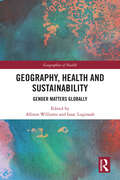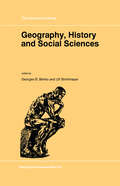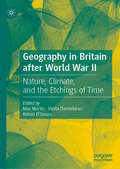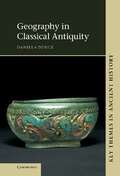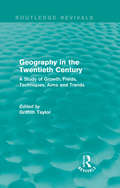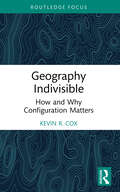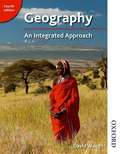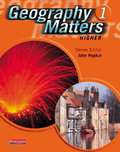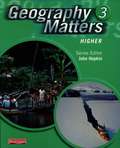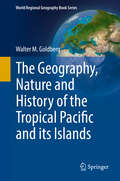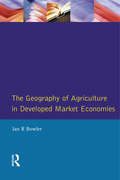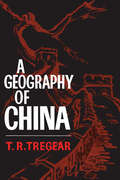- Table View
- List View
Geography, Health and Sustainability: Gender Matters Globally (Geographies of Health Series)
by Allison Williams Isaac LuginaahWith a global commitment to achieve gender equality by 2030, the SDGs present a historic opportunity to place gender as central to human progress across the globe. Gender equality, which requires the empowerment of all women and girls, is an explicit goal, in addition to being a fundamental prerequisite to and facilitator of most other SDGs. This edited collection provides a range of geographical and geospatial insights, from a variety of disciplinary and country-specific perspectives, to better understand gender and sustainable development. In addition to several African countries, Mexico, Japan, Canada, USA, and Cambodia are featured. A range of topical case studies examine women’s domestic and care work, including water collection, breastfeeding, food purchasing, and caring for elderly family members. Access to health care services is examined in the case of breast screening and antenatal care. Women’s engagement in the labour force is also addressed, with a specific look at the renewable energy sector; structural barriers to employment are discussed across a number of chapters, with clear strategies to break through these barriers. Finally, theoretical insights are proposed in better understanding and engaging in gendered inequalities in health.
Geography, History and Social Sciences (GeoJournal Library #27)
by Georges B. Benko Ulf StrohmayerGeorges Benko «Societies are much messier than our theories of them» Michael Mann The Sources of Social Power 1 Towards a unified social theory Why are there communication problems between the different disciplines of the social sciences? And why should there be so much misunderstanding? Most probably because the encounter of several disciplines is in fact the encounter of several different histories, and therefore of several different cultures, each interpreting the other according to the code dictated by its own culture. Inevitably geographers view other disciplines through their own cultural filter, and even a benevolent view remains 'ethnocentric'. It was in order to avoid such ethnocentricity that Femand Braudel called for more unity among the social sciences in 1958 : «l wish the social sciences . . . would stop discussing their respective differences so much . . . and instead look for common ground . . . on which to reach their first agreement. Personally I would call these ways : quantification, spatial awareness and 'longue duree'». In its place at the center of the social sciences, geography reduces all social reality to its spatial dimensions. Unfortunately, as a discipline, it considers itself all too often to be in a world of its own. There is a need in France for a figure like Vidal de la Blanche who could refocus attention away from issues of time and space, towards space and social reality. Geographic research will only take a step forward once it learns to address the problems facing all the sciences.
Geography in Britain after World War II: Nature, Climate, and the Etchings of Time
by Max Martin Vinita Damodaran Rohan D’SouzaContemporary anxieties about climate change have fueled a growing interest in how landscapes are formed and transformed across spans of time, from decades to millennia. While the discipline of geography has had much to say about how such environmental transformations occur, few studies have focused on the lives of geographers themselves, their ideologies, and how they understand their field. This edited collection illuminates the social and biographical contexts of geographers in postwar Britain who were influenced by and studied under the pioneering geomorphologist, A. T. Grove. These contributors uncover the relationships and networks that shaped their research on diverse terrains from Africa to the Mediterranean, highlighting their shared concerns which have profound implications not only for the study of geography and geomorphology, but also for questions of environmental history, ecological conservation, and human security.
Geography In Classical Antiquity (Key Themes In Ancient History Ser.)
by Daniela Dueck Kai BrodersenGeography in the Twentieth Century: A Study of Growth, Fields, Techniques, Aims and Trends (Routledge Revivals)
by Griffith TaylorThis title, first published in 1951, examines the growth, fields, techniques, aims and trends of geography at the time. The book is divided into three parts, of which the first deals with the evolution of geography and its philosophical basis. The second is concerned with studies of special environments and with advances in geomorphology, meteorology, climate, soils and regionalism. The last part describes field work, sociological and urban aspects, the function of the Geographical Society and geo-pacifics. Geography in the Twentieth Century will be of interest to students of both physical and human geography.
Geography in the Twentieth Century: A Study of Growth, Fields, Techniques, Aims and Trends (Routledge Revivals)
by Griffith TaylorThis title, first published in 1951, examines the growth, fields, techniques, aims and trends of geography at the time. The book is divided into three parts, of which the first deals with the evolution of geography and its philosophical basis. The second is concerned with studies of special environments and with advances in geomorphology, meteorology, climate, soils and regionalism. The last part describes field work, sociological and urban aspects, the function of the Geographical Society and geo-pacifics. Geography in the Twentieth Century will be of interest to students of both physical and human geography.
Geography Indivisible: How and Why Configuration Matters
by Kevin R. CoxIn a context of disciplinary division between human and physical geography, the book seeks to reassert the unity of the field through an emphasis on a shared focus on the geographic configuration of things and how and why configuration is important. It first examines previous approaches to reestablishing unity, and why they have failed, before moving on to an explanation of fundamental differences in what is being studied and how. The role of configuration looms large in both. This is in the sense of contingency and the idea of emergence, suggesting that reconstruction of unity can proceed through an exchange of models of understanding. This book will appeal to those teaching courses or seminars in geographic thought or in the history of geographic thought.
Geography Indivisible: How and Why Configuration Matters
by Kevin R. CoxIn a context of disciplinary division between human and physical geography, the book seeks to reassert the unity of the field through an emphasis on a shared focus on the geographic configuration of things and how and why configuration is important. It first examines previous approaches to reestablishing unity, and why they have failed, before moving on to an explanation of fundamental differences in what is being studied and how. The role of configuration looms large in both. This is in the sense of contingency and the idea of emergence, suggesting that reconstruction of unity can proceed through an exchange of models of understanding. This book will appeal to those teaching courses or seminars in geographic thought or in the history of geographic thought.
Geography, Institutions and Regional Economic Performance (Advances in Spatial Science)
by Riccardo Crescenzi and Marco PercocoThe book aims to present “traditional features” of regional science (as geographical concepts and institutions), as well as relatively new topics such as innovation and agglomeration economies. In particular it demonstrates that, contrary to what has been argued by recent economics literature, both geography and institutions (or culture) are relevant for local development. In fact, these phenomena, along with the movement of goods and workers, are among the main reasons for persisting development differentials. These intriguing relationships are at the heart of the analysis presented in this book and form the conceptual basis for a promising institutional approach to economic geography.
Geography - An Integrated Approach (Fourth Edition): Student Book (PDF)
by David WaughA new edition of David Waugh's popular A level Geography text, offering comprehensive, global and in-depth coverage. Stimulate students with clear, in-depth material suitable for all A Level specifications and is also suitable for the Scottish Higher/Advanced Higher and international specifications. Content revised and updated throughout to reflect latest events, theories, concepts and terminology, with new case and place studies. Completely revised questions, written by AS and A level examiners for thorough examination practice.
Geography Matters 1: Higher (PDF)
by Nicola Arber Linda Thompson Sue Lomas Garrett Nagle Paul ThompsonGeography Matters is a Key Stage 3 course created for pupils of all abilities. It provides an exact match to the requirement of the revised National Curriculum, and to the units of the Key Stage 3 Scheme of Work. Contents include: Making connections Restless Earth People everywhere Flood disaster Exploring England World sport
Geography Matters 3: Higher (PDF)
by Lisa Owen Sue Lomas Paul Thompson Garrett Nagle Nicola Arber Roger Sanders Linda Thompson Rob BowdenGeography Matters is a Key Stage 3 course created for pupils of all abilities. The pupil textbooks for year nine are parallel in their content coverage but are set at different levels, Foundation and Higher, to provide material at the right level and pace for both less able and more able pupils. Pupil books emphasize investigation skills, and integrated geographical skills such as map work and data analysis. The activities are linked to literacy and numeracy and have integrated ICT skills. Regular tasks provide feedback on progress and extention activities.
The Geography, Nature and History of the Tropical Pacific and its Islands (World Regional Geography Book Series)
by Walter M. GoldbergThis volume provides an accessible scientific introduction to the historical geography of Tropical Pacific Islands, assessing the environmental and cultural changes they have undergone and how they are affected currently by these shifts and alterations. The book emphasizes the roles of plants, animals, people, and the environment in shaping the tropical Pacific through a cross-disciplinary approach involving history, geography, biology, environmental science, and anthropology. With these diverse scientific perspectives, the eight chapters of the book provide a comprehensive overview of Tropical Pacific Islands from their initial colonization by native peoples to their occupation by colonial powers, and the contemporary changes that have affected the natural history and social fabric of these islands. The Tropical Pacific Islands are introduced by a description of their geological formation, development, and geography. From there, the book details the origins of the island's original peoples and the dawn of the political economy of these islands, including the domestication and trade of plants, animals, and other natural resources. Next, readers will learn about the impact of missionaries on Pacific Islands, and the affects of Wold War II and nuclear testing on natural resources and the health of its people. The final chapter discusses the islands in the context of natural resource extraction, population increases, and global climate change. Working together these factors are shown to affect rainfall and limited water resources, as well as the ability to sustain traditional crops, and the capacity of the islands to accomodate its residents.
Geography of Agriculture in Developed Market Economies, The
by I. R. BowlerFirst published in 1993. Routledge is an imprint of Taylor & Francis, an informa company.
Geography of Agriculture in Developed Market Economies, The
by I. R. BowlerFirst published in 1993. Routledge is an imprint of Taylor & Francis, an informa company.
The Geography of Albania: Problems and Perspectives (World Regional Geography Book Series)
by Dhimitёr Doka Perikli QiriaziThis book is the first to give a comprehensive and detailed overview of the complete geography of Albania in English. It highlights the most important and manifold potentials of nature, society and economy of Albania as well as development problems during different time periods. One focus lies on Albania's perspectives and challenges for the future.Beside natural aspects also topics such as migration, poverty, social situation, economy, urban development, regional disparities among others are discussed.This book appeals to academics and researchers of geography, regional development and related disciplines as well as teachers and students of geography, geology, natural sciences, social sciences, economics. The book is also attractive for media representatives, tourists and other interested individuals travelling to Albania.
The Geography of Beer: Culture and Economics
by Nancy Hoalst-Pullen Mark W. PattersonThis book builds on the highly successful Geography of Beer: Regions, Environment, and Society (2014) and investigates the geography of beer from two expanded perspectives: culture and economics. The respective chapters provide case studies that illustrate various aspects of these themes. As the beer industry continues to reinvent itself and its economic and cultural geographies, this book showcases historical, current, and future trends at the local, regional, national, and international scales.
The Geography of Beer: Regions, Environment, and Societies
by Mark Patterson Nancy Hoalst-PullenThis edited collection examines the various influences, relationships, and developments beer has had from distinctly spatial perspectives. The chapters explore the functions of beer and brewing from unique and sometimes overlapping historical, economic, cultural, environmental and physical viewpoints.Topics from authors – both geographers and non-geographers alike – have examined the influence of beer throughout history, the migration of beer on local to global scales, the dichotomous nature of global production and craft brewing, the neolocalism of craft beers, and the influence local geography has had on beer’s most essential ingredients: water, starch (malt), hops, and yeast.At the core of each chapter remains the integration of spatial perspectives to effectively map the identity, changes, challenges, patterns and locales of the geographies of beer.
The Geography of Beer: Policies, Perceptions, and Place
by Mark W. Patterson Nancy Hoalst-PullenThis book focuses on the geography of beer in the contexts of policies, perceptions, and place. Chapters examine topics such as government policies (e.g., taxation, legislation, regulations), how beer and beerscapes are presented and perceived (e.g., marketing, neolocalism, roles of women, use of media), and the importance of place (e.g., terroir of ingredients, social and economic impacts of beer, beer clubs). Collectively, the chapters underscore political, cultural, urban, and human-environmental geographies that underlie beer, brewing, and the beer industry.
The Geography of Black Pepper (Piper nigrum): The "King" of Spices – Volume 1
by Kodoth Prabhakaran NairThis book considers all aspects of black pepper from its growth, as a flowering vine, to how the dried fruit (peppercorn) is used as a spice and traded as a commodity. It is the economic mainstay of several India states and, principally, in Kerala State, with the Indian subcontinent being the largest black pepper producer. Indonesia has also emerged as a large producer of black pepper. Black pepper commands a leading position among the spices and has an immense commercial importance to world trade, finding its way onto the dining table of millions around the world, on the European and North American continents, and Japan. The use of black pepper ranges from a simple dietary component and flavour enhancer, to that of a spice with huge pharmacological benefits.
The Geography of Bosnia and Herzegovina: Between East and West (World Regional Geography Book Series)
by Haris Gekić Aida Bidžan-Gekić Nusret Drešković Ranko Mirić Péter ReményiThis monograph provides a comprehensive overview of fundamental scientific insights into the geographical features of a country which was and still is in the centre of the geopolitical battle of the large world powers and especially neighboring countries. The book presents the scientifically proven reserves of individual resources such as: mineral riches, land, forests, flora and fauna, water and climate features, to the extent needed, through statistical indicators and geographic maps. The authors point to features and specifics of the existing interdependence of economic and political development and impact of natural resources on spatial development which can be useful for potential investors, spatial planers, decision makers, politicians, geographers, students, large Bosnian diaspora and anyone interested in area of Bosnia and Herzegovina. This book fills the gap in geographical literature on Bosnia and Herzegovina in the English language. The monograph appeals to researchers and scholars of all levels in the fields of geography, geopolitics, history and related fields and everyone interested in this country between East and West.
The Geography of Cardamom (Elettaria cardamomum M.): The "Queen" of Spices – Volume 2
by Kodoth Prabhakaran NairThis book catalogues the multi-scale impact of agronomy and economy on Cardamom, known as the “Queen” of spices. Cardamom is the second most important spice crop in the world, after Black pepper, known as the “King” of spices. Spices were the symbols of luxury and royalty, and cardamom was used in the manufacture of perfumes during the Greek and Roman times. It became one of the most important Oriental spices used in both Greek and Roman cuisine as well as its pharmacological applications. The book is divided into 15 chapters and concentrates on aspects of cardamom production and processing, the taxonomic aspects of cardamom, chemistry, pathology, entomology and is concluded with the future of cardamom. Special emphasis is given to the utility of “The Nutrient Buffer Power Concept”, a soil management technique in precise fertilizer management, especially with regard to Potassic fertilizers in cardamom production.
The Geography of Central Asia: Human Adaptations, Natural Processes and Post-Soviet Transition (World Regional Geography Book Series)
by Igor Jelen Angelija Bučienė Francesco Chiavon Tommaso Silvestri Katie Louise ForrestThis book provides a profound geographical description and analysis of Central Asia. The authors take a synthetic approach in a period of critical transformation in the post-soviet time. The monograph analyzes comprehensively the physical and human geography as well as human-nature interactions of Central Asia with focus on Kazakhstan, Uzbekistan, Turkmenistan, Kyrgyzstan and Tajikistan. Natural processes are described at a systemic scale, focusing on ecological impacts and consequences and contemporary human adaptations and organization. It also discusses in which ways the human organizations try to apply solutions for their needs such as security, territorial management and resources renewability, material and functional needs, identity elaborations, culture and communication. The Geography of Central Asia appeals to scientists and students of regional geography and interested academics from other areas such as social, political, economic and environmental studies within the context of Central Asia. The book is also a very useful resource for field trips into this area.
A Geography of China
by T.R. TregearThis book is intended primarily for serious students of geography but it will also appeal to the general reader. For this reason technical terms have been used as sparingly as is consistent with correct meaning. Wherever the subject matter permits, the author emphasizes geographical growth and shows the interaction of geographical environment and the human activity and institutions. When originally published in the 1960s China was beginning to change with breathtaking rapidity. These changes are presented here against geographical and historical background. Knowledge of the environmental facts is essential to an appreciation of the political, economic, and social problems that have faced the Chinese people.
A Geography of China
by T.R. TregearThis book is intended primarily for serious students of geography but it will also appeal to the general reader. For this reason technical terms have been used as sparingly as is consistent with correct meaning. Wherever the subject matter permits, the author emphasizes geographical growth and shows the interaction of geographical environment and the human activity and institutions. When originally published in the 1960s China was beginning to change with breathtaking rapidity. These changes are presented here against geographical and historical background. Knowledge of the environmental facts is essential to an appreciation of the political, economic, and social problems that have faced the Chinese people.
